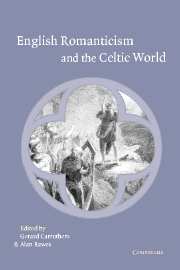Book contents
- Frontmatter
- Contents
- List of contributors
- Acknowledgements
- 1 Introduction: romancing the Celt
- 2 Sir William Jones, the Celtic Revival and the Oriental Renaissance
- 3 The critical response to Ossian's Romantic bequest
- 4 Blake and Gwendolen: territory, periphery and the proper name
- 5 The Welsh American dream: Iolo Morganwg, Robert Southey and the Madoc legend
- 6 Wordsworth, North Wales and the Celtic landscape
- 7 The force of ‘Celtic memories’ in Byron's thought
- 8 Shelley, Ireland and Romantic Orientalism
- 9 Byron and the ‘Ariosto of the North’
- 10 Scott and the British tourist
- 11 Felicia Hemans, Byronic cosmopolitanism and the ancient Welsh bards
- 12 Luttrell of Arran and the Romantic invention of Ireland
- 13 Contemporary Northern Irish poets and Romantic poetry
- Notes
- Bibliography
- Index
10 - Scott and the British tourist
Published online by Cambridge University Press: 22 September 2009
- Frontmatter
- Contents
- List of contributors
- Acknowledgements
- 1 Introduction: romancing the Celt
- 2 Sir William Jones, the Celtic Revival and the Oriental Renaissance
- 3 The critical response to Ossian's Romantic bequest
- 4 Blake and Gwendolen: territory, periphery and the proper name
- 5 The Welsh American dream: Iolo Morganwg, Robert Southey and the Madoc legend
- 6 Wordsworth, North Wales and the Celtic landscape
- 7 The force of ‘Celtic memories’ in Byron's thought
- 8 Shelley, Ireland and Romantic Orientalism
- 9 Byron and the ‘Ariosto of the North’
- 10 Scott and the British tourist
- 11 Felicia Hemans, Byronic cosmopolitanism and the ancient Welsh bards
- 12 Luttrell of Arran and the Romantic invention of Ireland
- 13 Contemporary Northern Irish poets and Romantic poetry
- Notes
- Bibliography
- Index
Summary
The eighteenth-century tourist was often a member of the gentry or aristocracy undertaking the Grand Tour, travel in Continental Europe which ‘involved essentially a trip to Paris and a tour of the principal Italian cities, namely Rome, Venice, Florence and Naples’. As the century progressed, there was an ‘expansion of foreign tourism’ as well as the development of tourism within the British Isles: these formed part of the move towards ‘a more widespread consumerism that was general throughout both the social elite and the middling orders’, as the advent of a mass advertising market through the expanding print media helped to consolidate a more unified British middle class. In particular, there was a growth of travel for pleasure: a French envoy reported in 1772 that ‘leurs voyages n'ayant eu pour objet que leur curiosité’. That curiosity could be satisfied within Britain as well as outside it: and despite the noted lack of tourist facilities, there were several prominent tours of Scotland after the Rising of 1745: Sir William Burrell's in 1758, Thomas Pennant's in 1769 and, most famously, that of Samuel Johnson and James Boswell in 1773. In 1792 the beginning of the Revolutionary war cut off much of fashionable Europe (though Mary Wollstonecraft famously travelled to unfashionable Scandinavia in 1795), and as a consequence it became more likely that tourists would travel within the British Isles.
Both leisured upper-class and more straitened middle-class tourists held in common the idea of the locus amoenus, the spirit of place and location.
- Type
- Chapter
- Information
- English Romanticism and the Celtic World , pp. 151 - 166Publisher: Cambridge University PressPrint publication year: 2003
- 3
- Cited by



